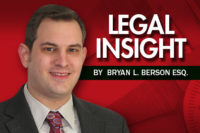Legal Insight
Risk Avoidance
Avoiding and managing risks with insurance.

Risk can’t be discussed in general terms. Risks are specific in nature. Executives, entrepreneurs and consumers should identify and describe risks as articulately as possible. Usually, they involve some risk of loss. Where possible, risks should be avoided, but risks that cannot be avoided should be managed by transferring or insuring them.
Risk avoidance is straightforward. One identifies how losses may occur and takes affirmative measures to prevent or decrease the probability of loss. This is a good investment of time and resources.
In manufacturing, injury is one of the most significant risks. It can kill or maim a person, ruin the person’s life, and cost the worker and company a fortune. Among other things, injuries can be caused by defective equipment, cramped space, insufficient safeguards, unclean conditions, poor lighting and ventilation, unsuitable clothing, carelessness, insufficient training, and distraction.
Risk avoidance can take many forms. Dangerous equipment should have safeguards. Operators should wear appropriate safety gear and snug uniforms. Long hair should be tied up, pinned back, covered or trimmed. Netting and railings should be installed where appropriate. Aisles must be unobstructed. Machines should be modified so they can only be activated deliberately, and operators must be trained properly to use them. These precautions can protect against a lawsuit for negligence.
Risks that cannot be avoided should be managed or transferred. Some contracts contain liability provisions. An insurance policy is the most common type of risk transfer device. It is a contract between an insurance company and insured. The company agrees to pay claims specified in the policy in exchange for a premium.
The company’s actuaries calculate the probability of a specific risk of loss with regard to a given population. Applicants submit detailed information that underwriters use to generate a premium quote. Insurance companies invest their surplus funds to earn a return, and pay insureds who experience a covered loss and notify the company of a valid claim. (Government-sponsored “social insurance” programs are not insurance. Usually, the programs incorporate wealth re-distribution. Their analyses of risks and premiums do not necessarily yield a long-term surplus. This is politics and ideology, not business.)
There are many different types of insurance. Vehicle owners must purchase automotive insurance. Usually, real estate owners must insure against fire. They can insure against damage caused by floods and natural disasters. Personal property can be insured. Under a general liability policy, an insurance company will pay a stated amount to defend claims and pay damages. Life insurance covers the risk of premature death. Long-term disability insurance covers long-term illnesses. Major medical health insurance covers illnesses. Umbrella policies cover catastrophic events and gaps not covered by the other policies. A good insurance agent can help develop a comprehensive plan. One should try to not over-insure or under-insure.
Insureds should carefully inventory their covered assets. Photos and videos provide a useful, efficient means of documentation.
Comparisons of insurance policies cannot be made on price alone. One must read the policies to determine what risks they cover. There is no use paying for insurance that doesn’t protect against relevant risks. Also, one should research the financial strength and practices of the insurer. A company that underwrites too many bad risks or runs its operations poorly could go out of business. A company with a reputation for not paying legitimate claims or paying them late does not help honest insureds.
A.M. Best is a private insurance rating agency that analyzes and rates insurance companies. Its highest ratings for financial strength are A++, A+ and A. The ratings run all the way down to F (liquidation) and S (suspension). Focus on companies rated A or higher. Even a low priced insurance premium is overpriced if the product is worthless.
Insureds who anticipate less risk can choose to pay a lower premium by carrying a deductible. One may choose not to insure against very unlikely risks. Rare, irreplaceable assets may be best protected through off-site storage in a vault or safe-deposit box. Never risk more than you can afford to lose.
Editor’s note: This column does not constitute legal advice.
Looking for a reprint of this article?
From high-res PDFs to custom plaques, order your copy today!



